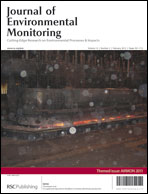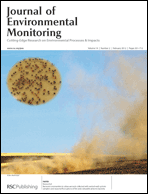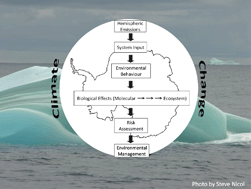
The images on the cover both have an aerosol theme, the first highlighting the article from Nils Petter Skaugset et al. presented at AIRMON 2011 on the exposure of aluminium production workers to beryllium,
Occupational exposure to beryllium in primary aluminium production
Nils Petter Skaugset, Dag G. Ellingsen, Kari Dahl, Ivar Martinsen, Lars Jordbekken, Per Arne Drabløs and Yngvar Thomassen
DOI: 10.1039/C1EM10539F

Bacterial communities in urban aerosols collected with wetted-wall cyclonic samplers and seasonal fluctuations of live and culturable airborne bacteria
Subbarao V. Ravva, Bradley J. Hernlem, Chester Z. Sarreal and Robert E. Mandrell
DOI: 10.1039/C1EM10753D
The issue also includes our regular Environmental Digest from Mike Sharpe, collating the latest environmental news including the Durban talks, a new directive on waste electrical and electronic equipment and the EU ban on phosphate detergents.
Other hot papers in this issue:
Interlaboratory evaluation of trace element determination in workplace air filter samples by inductively coupled plasma mass spectrometry
Kevin Ashley, Stanley A. Shulman, Michael J. Brisson and Alan M. Howe
DOI: 10.1039/C1EM10695C
Occurrence and fate of androgens, estrogens, glucocorticoids and progestagens in two different types of municipal wastewater treatment plants
Shan Liu, Guang-Guo Ying, Jian-Liang Zhao, Li-Jun Zhou, Bin Yang, Zhi-Feng Chen and Hua-Jie Lai
DOI: 10.1039/C1EM10783F
Enantioselective aquatic toxicity of current chiral pesticides
Quan Zhang, Cui Wang, Xiaofeng Zhang, Daqing Jin, Changjiang Huang and Meirong Zhao
DOI: 10.1039/C1EM10687B












 Wunmi Sadik
Wunmi Sadik Professor
Professor  Professor Liang-Hong Guo is a principal investigator and group leader at the Center for Eco-environmental Sciences, Chinese Academy of Sciences. His current research interests include biosensors and bioassays for quantitative determination of environmental chemicals and chemical toxicity testing, interactions of environmental chemicals with biological molecules and their toxicological implications, and nanomaterials for water purification.
Professor Liang-Hong Guo is a principal investigator and group leader at the Center for Eco-environmental Sciences, Chinese Academy of Sciences. His current research interests include biosensors and bioassays for quantitative determination of environmental chemicals and chemical toxicity testing, interactions of environmental chemicals with biological molecules and their toxicological implications, and nanomaterials for water purification. Professor
Professor  The release of engineered nanomaterials to the environment
The release of engineered nanomaterials to the environment Persistent organic pollutants in Antarctica: current and future research priorities
Persistent organic pollutants in Antarctica: current and future research priorities 
